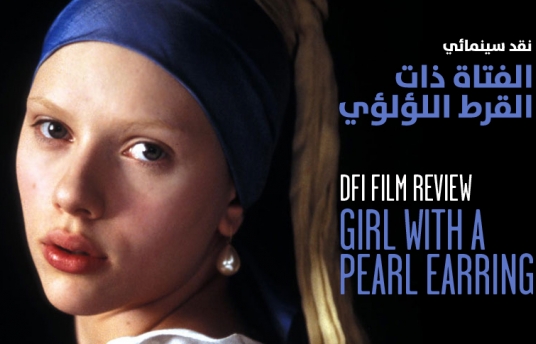نقد سينمائي: الفتاة ذات القرط اللؤلؤي (2003)
07 يونيو 2011

بقلم ريم شدّاد، قسم الاعلام الجديد، مؤسسة الدوحة للأفلام
الفيلم: الفتاة ذات القرط اللؤلؤي
العام: 2003
إخراج: بيتر وبر
بطولة: سكارليت جوهانسون، كولن فرث، توم ويلكنسون
النوع: سيرة حياة، دراما، رومانسية
يروي فيلم بيتر وبر الأول ‘الفتاة ذات القرط اللؤلؤي’ قصة اللوحة الرائعة التي رسمها فرمير عام 1665 والتي تحمل الاسم ذاته، وتعرف أيضاً “بموناليزا الشمال”. كما أن الفيلم مقتبس عن الرواية التي ألفها ترايسي شوفالييه عام 1999، والتي تحمل أيضاً عنوان ‘الفتاة ذات القرط اللؤلؤي’. وحصد الفيلم شعبية كبيرة إبان صدوره عام 2003، وحاز على جوائز من مهرجان بافتا، وترشح لجوائز في مهرجانيْ الأوسكار والغولدن غلوب، مما رفع أسهم مخرجه بيتر وبر وممثليه أيضاً. في ذلك الوقت، كانت البطلة سكارليت جوهانسون، التي لعبت دور غريت، الخادمة ذات الستة عشر ربيعاً في بيت فرمير، شابة نضرة في التاسعة عشر من عمرها. وإلى جانب ‘لوست إن ترانسلايشن‘، يعتبر فيلم ‘الفتاة ذات القرط اللؤلؤي‘بأنه من وضع الممثلة جوهانسون على خارطة السينما.
دخلت جوهانسون عالم السينما من أوسع أبوابها، حين قامت ببطولة فيلم إلى جانب ممثلين كبار أمثال كولن فرث، توم ويلكنسون، سيليان مورفي والجميلة الأسترالية أيسي دايفس، لا سيما أن فريق الممثلين كان مثيراً للاعجاب، وخال من الاشتباك الذي كان يمكن أن ينتج عن جمع هذا العدد من الأسماء الكبيرة في فيلم واحد. وتجري أحداث الفيلم في الجمهورية الهولنديه سيركا في القرن السابع عشر، حيث الهوة بين طبقة الأغنياء وطبقة الفقراء آخذة في المزيد من التوسّع. غريت (سكارليت جوهانسون)، هي صبية من عائلة متواضعة، ترسلها عائلتها للعمل في بيت فرمير المضطرب، حين يصبح والدها، رسام الخزف، ضريراً، وبالنتيجة عاطلاً عن العمل، بعد تعرضه لحادث مؤسف. أما يوهان فرمير (كولن فرث) فهو موهوب لكن غريب الأطوار، يقتصر عمله على رسم لوحات يطلبها منه سيده الثري بيتر فان رويجفن (توم ويلكنسون)، لكن وعلى الرغم من نفاذ شغفه ومصادر وحيه، يطلب منه إنتاج المزيد من الأعمال. ويؤدي ذلك بالطبع إلى وقوع عائلة فرمير في الديْن مع فان رويجفن، الذي يضغط على فرمير نفسه ويضعه في مواقف غير سارة.
وتبدأ غريت العمل تحت ناظريْ زوجة فرمير المهمَلة والحسود كاثارينا بولنز فرمير (إيسي دايفس)، وحماة فرمير المفترسة ماريا ثينز (جودي بافيت)، اللتان تستنفذا قواها بالعمل المضني، وخدمة العائلة ليلاً ونهاراً، حتى أثناء وضع كاثارينا لطفل. وبسبب مهامها اليومية، التي تتضمن القيام بمشاوير عديدة إلى السوق، تلتقي غريت ابن اللحام بيتر (مورفي)، الذي يؤخذ فوراً بخفة دمها. وعلى الرغم من شعور غريت بالاطراء من حركات بيتر الطفولية المليئة بالاعجاب بها، تنغمس بسرعة في عالم فرمير الفني المعقّد والمعذّب. ويحدث الشيء ذاته مع فرمير، لا سيما بعد أن يشعر أنه وجد ضالته ومصدر إلهامه فيها. وينشأ عن ذلك علاقة بسيطة لكنها مرفوضة من الطرفيْن. لسوء الحظ، لا تمر تصرفات غريت التي تسعى من خلالها إلى التقرّب والحصول على الرضى، دون ملاحظتها من قبل ماريا ثينز وفان رويجفن.
وفي الوقت الذي تبارك فيه ماريا ثينز سراً هذه العلاقة المتنامية بين الخادمة وزوج ابنتها – فقط بسبب الزيادة المفاجئة في إنتاجية فرمير نتيجة ذلك – تتجه اهتمامات فان رويجفن إلى نواحي أخرى. فيعبّر لها بشكل مقزّز عن حبه، مرتمياً عليها أولاً في بيت فرمير، ثم بطلب نقلها لخدمته في بيته. وحين يرفض فرمير بشدة هذا الطلب، يطلب منها فان رويجفن رسم لوحة لغريت – دون علم سيدة المنزل كاثارينا. اللوحة هي طبعاً ‘الفتاة ذات القرط اللؤلؤي‘، والتي تظهر فيها غريت وهي تضع قرطاً لامعاً من اللؤلؤ يتدلى من أذنها التي ثقبها لها فرمير نفسه، وأهدتها القرط ماريا ثينز نفسها. هذا التصرف وليد اليأس والطمع، بدلاً من الطيبة، ويرمز إلى فقدان البراءة والاحساس الحاد بالاستغلال. غير أن كاثارينا تكتشف أن قرط اللؤلؤ مفقود، فتتهم مباشرة الفتاة التي تجد نفسها فجأة تتنافس وإياها على حب زوجها: غريت.
إن الحميمية التي تولد من خلال حب الرسم، هو أمر لم تشارك فيه كاثارينا زوجها فرمير، كما أنها تشعر بأنها غريبة في بيتها، مع تذمرات من الخيانة حتى من قبل والدتها. ثم يتم طرد غريت من بيت فرمير، تغذيها مشاعر الغيرة والجهل والانحطاط.
لكنها تشعر بالحيرة حيال انعدام أية ردة فعل من قبل فرمير حيال رحيلها، غير أنها مصدر الكثير من المشاعر المضطربة في بيت فرمير بجميع من فيه، وحتى لدى فان رويجفن بعد تلقيه اللوحة. وتصبح آخر هدية تلقتها غريت، الوشاح الأزرق التي ارتدته من أجل اللوحة، بالاضافة إلى قرط اللؤلؤ الخاص بكاثارينا، رمزان للرابط العاطفي ما بين غريت وفرمير؛ وهو أمر يمكن أن يُعتبر غير مبرر ومرفوض. إنها قصة المواجهة ما بين القوة (فرمير) والبساطة (بيتر)؛ والمال (فان ريوجفن) مقابل الابداع (فرمير)؛ والعلاقة (غريت) مقابل الحقوق الزوجية (كاثارينا). ويبقى فيلم ‘ الفتاة ذات القرط اللؤلؤي’ من أهم الأفلام بعد أعوام من صدوره، وبعد قرون عديدة من إكمال اللوحة ذاتها.
Girl With A Pearl Earring - Trailer
إعلان فيلم الفتاة ذات القرط اللؤلؤي